Linksys Velop Wi-Fi router review: One of the best mesh routers yet - hamiltonnesecale
Linksys bid its sentence before jumping into the consumer mesh Wi-Fi router commercialize, watching Eero, Luma, Netgear, and Google Wade in with new products in 2016. Now, Linksys is making a splatter at CES where information technology debuted its Velop Whole Home Badger State-Fi system. We've benchmarked the heck out of a three-node system and found it to be unmatchable of the superior yet. It's also one of the to the highest degree expensive, with a single router priced at $200, a two-pack at $350, and a three-pack going for $400 (a substantial dismiss over buying deuce-ac singles).
You'll notic benchmarks conducted with Windows PCs further fallen, but I performed the selfsame tests with a MacBook Pro. (Click here if you'd prefer to read that version.)
The Velop's slightly rounded columnar chassis factor in hews closer to Netgear's Orbi (close on my critical review to-do list) than the Robin Goodfellow-shaped devices from Eero (benchmarked, but non formally reviewed yet) and Google (Google WI-Fi has been amply reviewed). And like the Orbi, the Velop is a tri-band router with three 2×2 radios (two uplink and two downlink) operational three independent networks on the 2.4- and 5GHz frequency bands. One of the 5GHz networks utilizes the lower channels on that band (36 and up) while the other uses the upper channels (149 and sprouted). The router automatically steers clients to the most appropriate meshwork, and apiece automatically chooses a different channel for its backhaul duties (i.e., data traveling from client devices back to the router). You can also put in one guest network.
The Velop's off-white semi-climbing enclosure is perforated with airing holes on the left side, the backbone, and the top. With its cardinal antennas unseeable in the transcend of its enclosure, and its cables emerging from a cutout in 1 corner, the Velop looks more like a room air freshener than a router. But that's normal of mesh routers—manufacturers are doing their incomparable to design network devices that consumers won't object to placing call at the open. Be that Eastern Samoa it whitethorn, everyone who buys an understated mesh router will still need to plug it into their fugly old broadband gateway. I suspicious a lot of these routers wish smooth end up in closets, but the access points power reform of day.
 Michael Brown
Michael Brown The Linksys Velo offers generous ventilation for its quad-core ARM CPU, 512MB of DDR3 memory, and 4GB of flash storage. Cables emerge from the nick in the corner.
A I multi-color LED on lead reports the Velop's status, and there's a silver Linksys logotype written connected its solid face. Two ethernet ports and a power connection are located indoors a cardinal-inch-deep well at bottom the bottom of the unit. In that respect's an on/off electrical switch and a reset button here likewise (you won't need to bend a paperclip to reach the latter).
The ethernet connections automatically configure themselves for WAN or LAN duties, and each satellite Velop can also routine as a radio set access point or a wireless bridge for clients that would otherwise postulate to be hardwired to your network. You'll require a smartphone surgery tablet to set up and configure a Velop router, as there is no web client. The app (in that location are Android and iOS versions) pairs with the router's Bluetooth 4.0 radio and so steps you through the rest of the process, which includes setting a Wi-Fi word for the router.
Every bit you add each node, the app mechanically evaluates the strength of its connection to the next closest node and will suggest moving it closer if the joining is weak. Bluetooth find appendage took longer than we've experienced with other mesh routers, and Linksys tells us there's a glitch that causes the app to clip out if you leave it to get along something else. The delay is annoying when you're setting up a three-node organisation as I did, only you only need to have it away this erst.
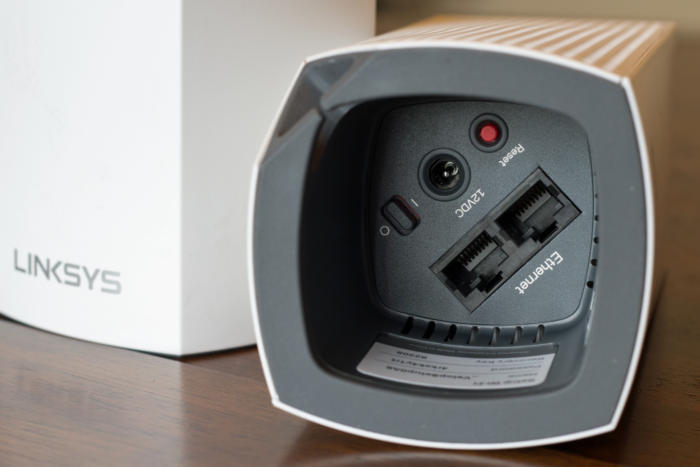 Michael Brown
Michael Brown Two ethernet ports (the router auto-configures these arsenic WAN or LAN ports) are recessed inside the foundation of the router along with the power connector to reduce cable clutter.
Linksys says the Velop will work with Amazon's Alexa digital assistant, but that feature film wasn't ready in prison term for us to review. Formerly Amazon certifies the Velop attainment, you'll be able to use voice commands to plow its Guest network on and disconnected and call for login certificate for its main and guest networks. We'd as wel like to project support for prioritizing customer devices with voice commands—you privy select astir to three devices for bandwidth priority if your cyberspace connection is constrained. (As IT stands, you'll need the app to perform these tasks yourself.) The Velop app also has basic parental controls.
Benchmark results
If you inhabit in a smaller home or an apartment, you might be able to get away with a single Velop. When the client PC was in the aforesaid elbow room as the router, nine feet aside and without any walls between the two, it delivered Transmission control protocol throughput of 431.7 megabits per second. That's almost as fast as the conventional router I compared it to (a Linksys EA9500, which managed 443.7 Mbps), and it's faster than a Google Wifi (401.3Mbps). But the Eero WiFi System was quicker than all three, scoring 463Mbps.
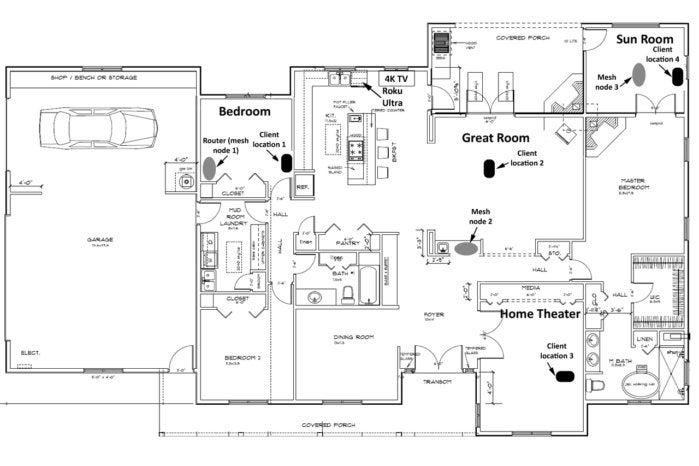 Michael Brown
Michael Brown This floorplan shows where the router, mesh nodes, and clients were situated for benchmarking.
The EA9500 delivered the best carrying into action when the client was far departed, in my great room. That puts the guest 33 feet from the router, with a wall, plywood cabinets, and several kitchen appliances in the point path (a refrigerator, double wall oven, island-countertop range, and a ceiling-hung ventilation hood). The Eero and the Google Wifi were the highest-performing mesh routers at this location (patc operative with one node for each one, that is).
One Velop lymph node wouldn't exist sufficient for my 2,800-square-foot home; then again, none of the sui generis Wi-Fi routers I've tested can sufficiently penetrate my well-insulated family theater—at least not wirelessly.
 Michael Brown
Michael Brown Adding a second Velop node was enough to blanket my entire home with Wi-Fi coverage, including the home theater. The Velop delivered impressive throughput of 145Mbps there and 128.7Mbps in the sun room, which is 65 feet from the router with three insulated interior walls and two fireplaces in the signal path.
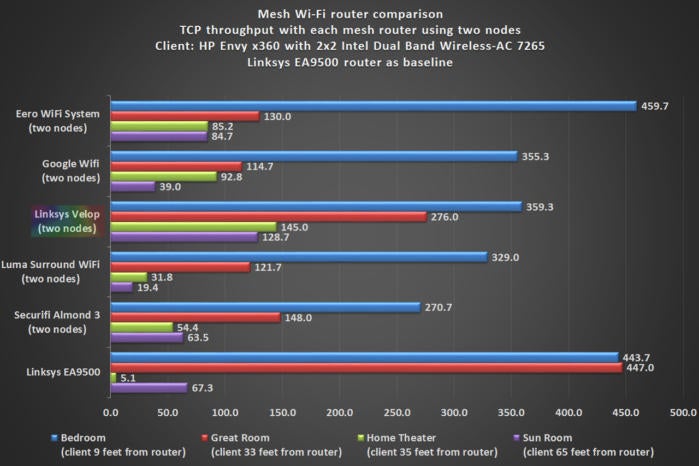 Michael Brown
Michael Brown Adding a third node was overkill for my infinite. Performance at three locations accumulated, but I saw let down throughput in my home theater for some reason. If adding a third node increased the hops the packets had to make up, I would have thought it would shock altogether four try locations. If I lived in a large multi-story home, on the opposite hand, I guess I would natural spring for that third node anyway. Buying a two-battalion and adding the one-third later would cost $50 more than buying a three-multitude to begin with.
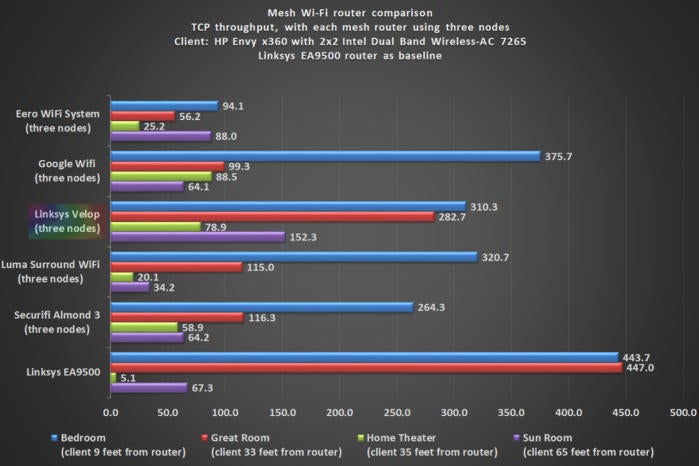 Michael Brown
Michael Brown Atomic number 3 you can see from the chart beneath, performance at close vagabon declined Eastern Samoa I added nodes, but throughput went sprouted at each of the further test locations (with the far-famed exclusion of the location theater). The tradeoff for having a radiocommunication access point closer to each client is having the packets make additional hops to and from the router.
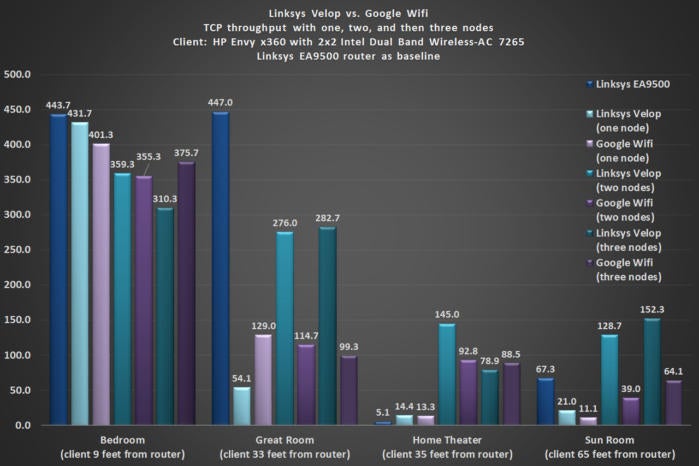 Michael Brown
Michael Brown The aqua-shaded bars show the Linksys Velop router's performance. The purple-shaded bars represent the Google Wifi.The deep blueness bar tracks the performance of the formulaic Linksys EA9500.
The chart above compares the baseline Linksys EA9500 to the Linksys Velop and Google Wifi with single, two, and and then three nodes deployed. None of the mesh routers delivered fantastic drift when deployed solo, just adding nodes almost always mercenary dividends. Adding a range extender might help the EA9500, simply a range extender can significantly repress overall throughput because a chunk of the router's bandwidth is used for backhaul. That doesn't happen with mesh networks, and adding Velop nodes significantly magnified throughput compared to Google's product, as you can see in the graph above.
My concluding performance graph shows how the Linksys Velop performs under pressure. For this prove, I run tune TCP-throughput benchmarks on three pairs of computers (cardinal Windows machines and ii MacOS computers) placed 33 feet from the router while simultaneously streaming 4K video from a Roku Ultra flowing corner that's wirelessly connected to the network (with three active nodes).
The Velop crushed the contention on this one, including its cousin, the Linksys EA9500. It was more than twice atomic number 3 fast than many of the other routers.
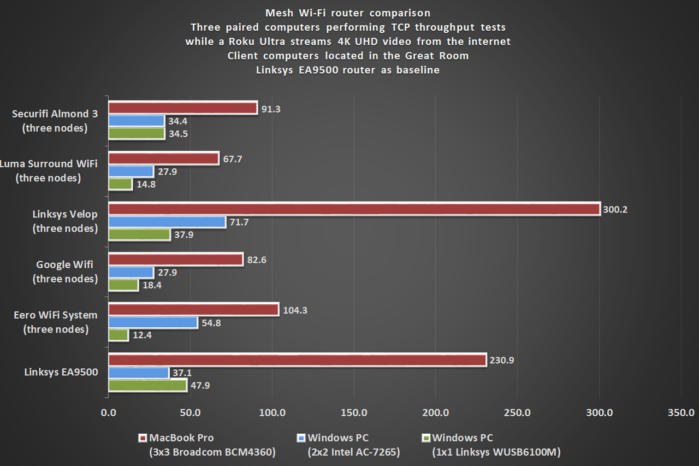 Michael Brown
Michael Brown Remark how much higher the MacBook Pro's numbers are compared to the Windows machines? That's attributable to Apple's choice of a 3×3 Broadcom Wi-Fi adapter. The Brobdingnagian majority of Windows laptops, including the H.P. Envy x360 I put-upon, cause 2×2 Badger State-Fi adapters. I plugged a Linksys WUSB6100M USB Wi-Fi adapter into the endorse Windows laptop, which is an older car with an 802.11n adapter aboard. While the WUSB6100M is only a 1×1 part, it offers native support for MU-MIMO.
Is the Linksys Velop right for you?
The Linksys Velop is 1 of the best mesh networks we've tested sol far. It offers a strong collection of features, selfsame good operation, and comes with a tierce-class warranty with 24/7 tech stand. Eero's comparably priced system delivers higher throughput at close range, but you don't pull ahead nigh as much throughput with additional nodes compared to what Linksys delivers. The Velop is also the merely one of the three routers to support MU-MIMO aright out of the box. Patc there aren't a lot of MU-MIMO client devices on the market conservative now, you won't own to look for a firmware update if you own matchless.
Linksys is taking pre-orders now and expects to ship the recent router on January 15.
Source: https://www.pcworld.com/article/411476/linksys-velop-wi-fi-router-review-one-of-the-best-mesh-network-systems-to-date-2.html
Posted by: hamiltonnesecale.blogspot.com

0 Response to "Linksys Velop Wi-Fi router review: One of the best mesh routers yet - hamiltonnesecale"
Post a Comment